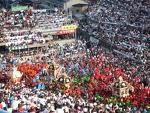:::::::::::::::::::::::::::::::::::::::::::::::::::::::::::::::::::::::::::::::::::::::::::::::::::
. Kigo Calendar - the 12 Months .
:::::::::::::::::::::::::::::::::::::::::::::::::::::::::::::::::::::::::::::::::::::::::::::::::::::
October - juugatsu 十月

.................... 01 .................................................................................
. Changing to winter robes (nochi no koromogae 後の更衣 .
. World Elders Day .
.................... 02 .................................................................................
. Memorial Day for Kaga no Chiyo-Ni 加賀千代 .
. Angel Festival 天使祭 .
. Mahatma Gandhi Birthday. 1947 - India .
Gandhi Jayanthi Day, Gandhi Jayanti
.................... 03 .................................................................................
. Memorial Day for Iida Dakotsu 蛇笏忌 .
. mizu hajimete karu 水始めて涸る
water dries out for the first time .
. Ceremony of the Komyo Mantra 光明真言会 .
Temple Saidai-Ji 西大寺, Nara, till October 5
.................... 04 .................................................................................
. Memorial Day for Takano Suju 高野素十 .
. World Animal Day .
.................... 05 .................................................................................
. Daruma Memorial Day 達磨忌 .
Bodhidharma, founder of the Zen sect
.................... 07 .................................................................................
. Our Lady of the Rosary ロザリオ祭 .
.................... 08 .................................................................................
. kanro 寒露 cold dew .
one of the 24 solar sections 二十四節気
.................... 09 .................................................................................
. Konpira Shrine Festival 金刀比羅祭 Kompira, Shikoku .
.................... 10 .................................................................................
. Health and Sports Day 体育の日 .
taiiku no hi
. World Homeless Day .
. Hero's Day (Mashujaa) - Kenya .
.................... 11 .................................................................................
. Memorial Day for Taneda Santoka 種田山頭火 .
. Memorial Day for William "Bill" Higginson .
.................... 12 .................................................................................
. Uzumasa Bull Festival 太秦の牛祭 Kyoto .
. Memorial Day for Utagawa Hiroshige 歌川広重 .
Ando Hiroshige 安藤広重
. Columbus Day - America .
.................... 13 .................................................................................
. Memorial Day for Saint Nichiren 日蓮忌 .
omeikoo 御命講 Omeiko memorial service
.................... 16 .................................................................................
. World Food Day .
. Niukawakami Shrine Festival 丹生川上祭 . Nara
.................... 17 .................................................................................
. World Poverty Day .
.................... 18 .................................................................................
. Chrysanthemum memorial ritual 菊供養 .
Asakusa Kannon Temple, Tokyo
.................... 20 .................................................................................
. Mashujaa (Heroes' ) Day - Kenya .
former Kenyatta Day
.................... 22 .................................................................................
. Kurama Temple Fire Festival 鞍馬の火祭 .
.................... 23 .................................................................................
. sookoo 霜降 Soko. frost descends .
one of the 24 solar sections 二十四節気
.................... 24 .................................................................................
. United Nations Day .
. International Day of Climate Action .
- World Environment Day
.................... 26 .................................................................................
. Lunar Chrysanthemum Festival 旧重陽 .
.................... 31 .................................................................................
. Halloween, Hallowe’en ハロウィーン .
.................... first SUNDAY
. Harvest Thanksgiving - Erntedankfest .
.................... second MONDAY
. Canadian Thanksgiving - Canada .
.................... middle of October
. Oktoberfest - Octoberfest - Munich, Germany .
. Breast Cancer Awareness Month . USA
.................................................................................
. WKD : October - a Haiku Month .
:::::::::::::::::::::::::::::::::::::::::::::::::::::::::::::::::::::::::::::::::::::::::::::::::::::
. WKD : World Days in October .
. Ceremonies, festivals, rituals - October .
. Memorial Days of Famous People - October .
:::::::::::::::::::::::::::::::::::::::::::::::::::::::::::::::::::::::::::::::::::::::::::::::::::::
For the worldwide approach to kigo,
we must differentiate between the "Haiku Season" and the natural phenomenon and human activites occuring at a certain season at a certain place.
To complicate our endeavor, we also have to deal with the Asian Lunar Calendar and the 24 seasons (periods), which were applied in Japan before the introduction of the Western Calendar, when kigo were already used in Japanese poetry.
Study the details here, please:
. The Japanese Haiku Calendar.
. Seasons beginning .
. Seasons ending .
:::::::::::::::::::::::::::::::::::::::::::::::::::::::::::::::::::::::::::::::::::::::::::::::::::::
continue :
. KIGO CALENDAR - November, December .
. WKD : the complete SAIJIKI list .
.................................................................................
BACK : Top of this Saijiki
[ . BACK to DARUMA MUSEUM TOP . ]
[ . BACK to WORLDKIGO . TOP . ]
:::::::::::::::::::::::::::::::::::::::::::::::::::::::::::::::::::::::::::::::::::::::::::::::::::::









































